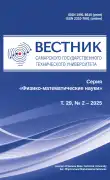Аналитическая формула и численный расчет второй гармоники динамической восприимчивости концентрированной феррожидкости
- Авторы: Русанов М.С.1
-
Учреждения:
- Уральский федеральный университет имени первого Президента России Б. Н. Ельцина
- Выпуск: Том 29, № 2 (2025)
- Страницы: 347-362
- Раздел: Математическое моделирование, численные методы и комплексы программ
- URL: https://bakhtiniada.ru/1991-8615/article/view/349675
- DOI: https://doi.org/10.14498/vsgtu2124
- EDN: https://elibrary.ru/NBPKKD
- ID: 349675
Цитировать
Полный текст
Аннотация
Методами аналитического и численного анализа исследуется вторая компонента динамической восприимчивости ансамбля взаимодействующих магнитных частиц. Рассматривается конфигурация наложенных друг на друга магнитных полей: переменного и параллельного ему постоянного. Диполь-дипольные взаимодействия учитываются в рамках двухчастичных корреляций с использованием подхода модифицированной теории среднего поля первого порядка.
Из аналитического решения уравнения Фоккера–Планка получено выражение для второй гармоники как функции двух параметров: восприимчивости Ланжевена $\chi_L$, характеризующей диполь-дипольные взаимодействия, и параметра Ланжевена $\xi_0$, представляющего собой отношение магнитной энергии к тепловой.
Полученное выражение для второй гармоники согласуется с ранее известными результатами, в которых межчастичными взаимодействиями пренебрегали. Проведенное исследование имеет значительный теоретический интерес и может быть использовано для более точной характеристики свойств магнитных частиц.
Полный текст
Открыть статью на сайте журналаОб авторах
Михаил Сергеевич Русанов
Уральский федеральный университет имени первого Президента России Б. Н. Ельцина
Автор, ответственный за переписку.
Email: mikhail.rusanov@urfu.ru
ORCID iD: 0000-0001-7439-8179
SPIN-код: 9081-7507
Scopus Author ID: 57306389700
ResearcherId: JNS-8758-2023
https://www.mathnet.ru/rus/person229346
инженер-исследователь; лаб. математического-моделирования физико-химических процессов в многофазных средах; департамент математики, механики и компьютерных наук; институт естественных наук и математики
Россия, 620002, Екатеринбург, ул. Мира, 19Список литературы
- Rosensweig R. E. Ferrohydrodynamics. New York: Cambridge, 1998. 344 pp.
- Al-Areqi A. R., Xiaogang Y., Renpeng Y., et al. Synthesis of zinc ferrite particles with high saturation magnetization for magnetic induction hyperthermia // J. Magn. Magnet. Mater., 2023. vol. 579, 170839. DOI: https://doi.org/10.1016/j.jmmm.2023.170839.
- Kritika, Indrajit R. Therapeutic applications of magnetic nanoparticles: recent advances // Material. Advances, 2022. vol. 3, no. 20. pp. 7425–7444. DOI: https://doi.org/10.1039/D2MA00444E.
- Stueber D. D., Villanova J., Aponte I., et al. Magnetic nanoparticles in biology and medicine: Past, present, and future trends // Pharmaceutics, 2021. vol. 13, no. 7, 943. DOI: https://doi.org/10.3390/pharmaceutics13070943.
- Lucaciu C. M., Nitica S., Fizesan I., et al. Enhanced magnetic hyperthermia performance of zinc ferrite nanoparticles under a parallel and a transverse bias DC magnetic field // Nanomaterials, 2022. vol. 12. pp. 419–588. DOI: https://doi.org/10.3390/nano12203578.
- Rusanov M. S., Kuznetsov M. A., Zverev V. S., Elfimova E. A. Influence of a bias dc field and an ac field amplitude on the dynamic susceptibility of a moderately concentrated ferrofluid // Phys. Rev. E, 2023. vol. 108, no. 2, 024607. EDN: LVREAX. DOI: https://doi.org/10.1103/PhysRevE.108.024607.
- Ivanov A. O., Camp P. J. How particle interactions and clustering affect the dynamic magnetic susceptibility of ferrofluids // J. Magn. Magnet. Mater., 2023. vol. 586, 171216. EDN: LXFRGI. DOI: https://doi.org/10.1016/j.jmmm.2023.171216.
- Lebedev A. V., Stepanov V. I., Kuznetsov A. A., et al. Dynamic susceptibility of a concentrated ferrofluid: The role of interparticle interactions // Phys. Rev. E, 2019. vol. 100, no. 3. EDN: JOCHQF. DOI: https://doi.org/10.1103/PhysRevE.100.032605.
- Debye P. Polar Molecules. New York: Chemical Catalog, 1929. 174 pp.
- Raikher Y. L., Stepanov V. I. Nonlinear dynamic susceptibilities and field-induced birefringence in magnetic particle assemblies / Advances in Chemical Physics. vol. 129, 2004. pp. 419–588. EDN: OGWEAD. DOI: https://doi.org/10.1002/047168077x.ch4.
- Ivanov A. O., Zverev V. S. Kantorovich S. S. Revealing the signature of dipolar interactions in dynamic spectra of polydisperse magnetic nanoparticles // Soft Matter, 2016. vol. 12, no. 15. pp. 3507–3513. EDN: XMDERI. DOI: https://doi.org/10.1039/c5sm02679b.
- Rusanov M. S., Zverev V. S., Elfimova E. A. Third harmonic of the dynamic magnetic susceptibility of a concentrated ferrofluid: Numerical calculation and simple approximation formula // Phys. Rev. E, 2024. vol. 110, no. 3. pp. 034605. EDN: UYCLLS. DOI: https://doi.org/10.1103/PhysRevE.110.034605.
- Rusanov M. S., Zverev V. S., Elfimova E. A. Influence of a bias dc field and an ac field amplitude on the dynamic susceptibility of a moderately concentrated ferrofluid // Phys. Rev. E, 2023. vol. 108, no. 2, 024607. EDN: LVREAX. DOI: https://doi.org/10.1103/PhysRevE.108.024607.
- Yoshida T., Enpuku K. Simulation and quantitative clarification of AC susceptibility of magnetic fluid in nonlinear Brownian relaxation region // Japan. J. Appl. Phys., 2009. vol. 48, no. 12R, 127002. DOI: https://doi.org/10.1143/JJAP.48.127002.
- Batrudinov T. M., Ambarov A. V., Elfimova E. A., et al. Theoretical study of the dynamic magnetic response of ferrofluid to static and alternating magnetic fields // J. Magn. Magnet. Mater., 2017. vol. 431. pp. 180–183. EDN: YUTRGN. DOI: https://doi.org/10.1016/j.jmmm.2016.09.094.
- Coffey W. T., Kalmyko Y. P., Nijun W. Nonlinear normal and anomalous response of non-interacting electric and magnetic dipoles subjected to strong AC and DC bias fields // Nonlinear Dyn., 2015. vol. 80. pp. 1861–1867. EDN: UOECOZ. DOI: https://doi.org/10.1007/s11071-014-1488-9.
- Déjardin J.-L., Debiais G., Ouadjou A. On the nonlinear behavior ofdielectric relaxation in alternating fields. II. Analytic expressions of the nonlinearsusceptibilities // J. Chem. Phys., 1993. vol. 98, no. 10. pp. 8149–8153. DOI: https://doi.org/10.1063/1.464570.
- Ivanov A. O., Kuznetsova O. B. Magnetic properties of denseferrofluids: An influence of interparticlecorrelations // Phys. Rev. E, 2001. vol. 64, no. 4, 041405. EDN: WJQLGO. DOI: https://doi.org/10.1103/PhysRevE.64.041405.
- Афанасьева Н. М., Вабищевич П. Н., Васильева М. В. Безусловно устойчивые схемы для задач конвекции-диффузии // Изв. вузов. Матем., 2013. №3. С. 3–15. EDN: PRYKHB.
- Ambarov A. V., Zverev V. S., Elfimova E. A. Numerical modeling of the magnetic response of interacting superparamagnetic particles to an ac field with arbitrary amplitude // Modelling Simul. Mater. Sci. Eng., 2020. vol. 28, no. 8, 085009. EDN: PCMKHA. DOI: https://doi.org/10.1088/1361-651X/abbfbb.
- Ambarov A. V., Zverev V. S., Elfimova E. A. Influence of field amplitude and dipolar interactions on the dynamic response of immobilized magnetic nanoparticles: Perpendicular mutual alignment of an alternating magnetic field and the easy axes // Phys. Rev. E, 2023. vol. 107, no. 2, 024601. EDN: ZNXBCM. DOI: https://doi.org/10.1103/PhysRevE.107.024601.
Дополнительные файлы









